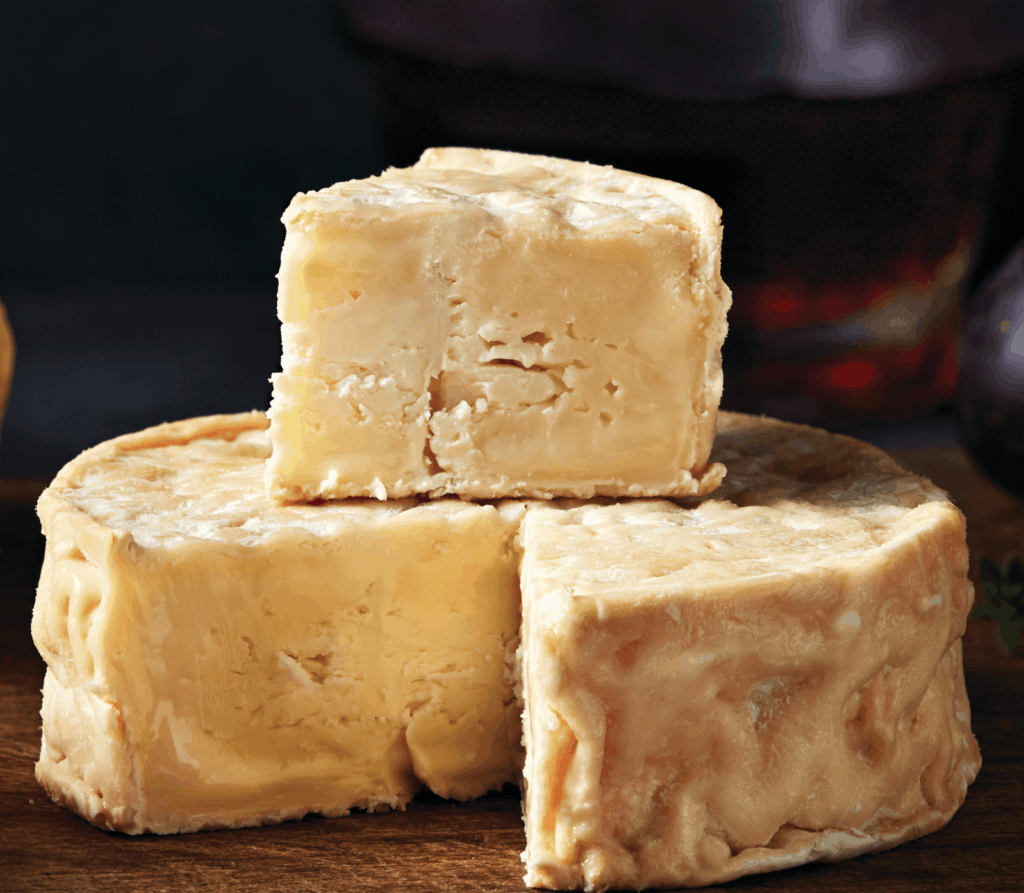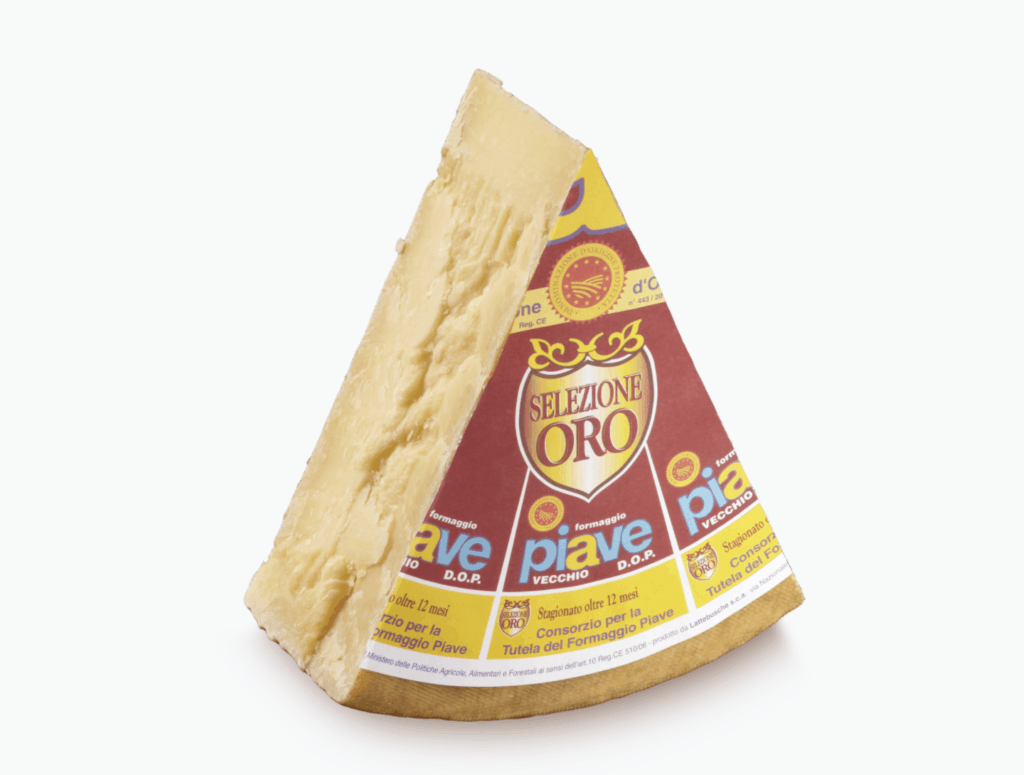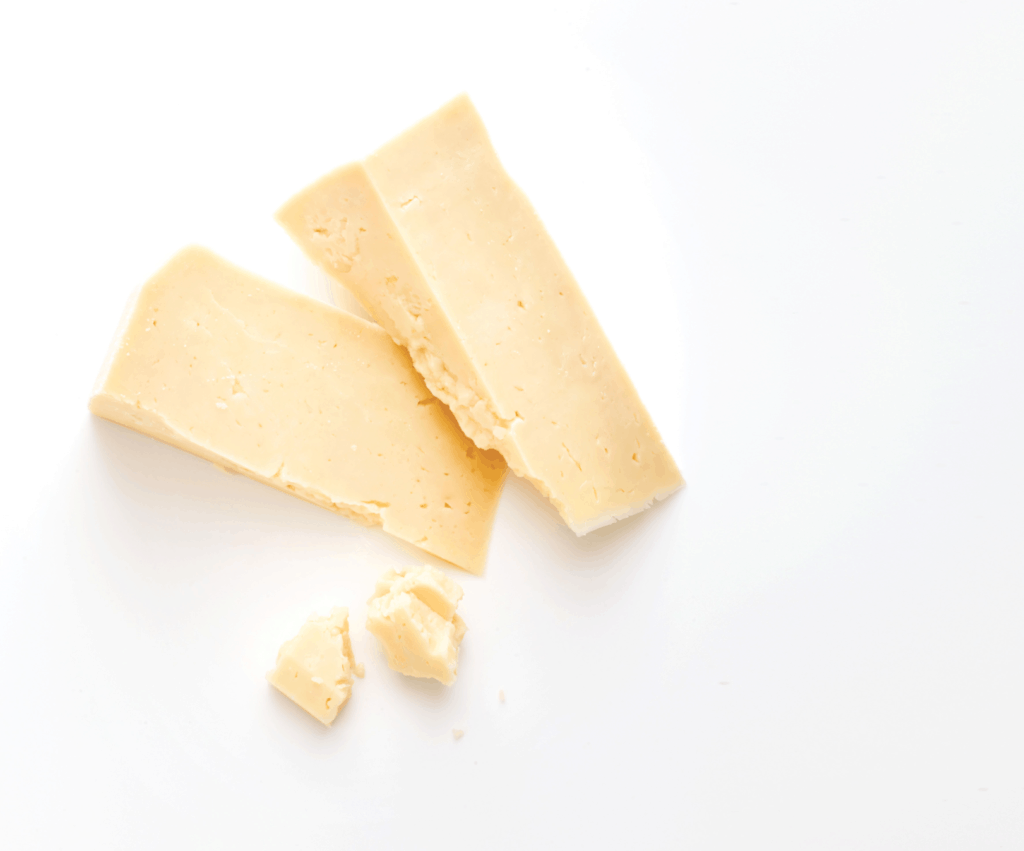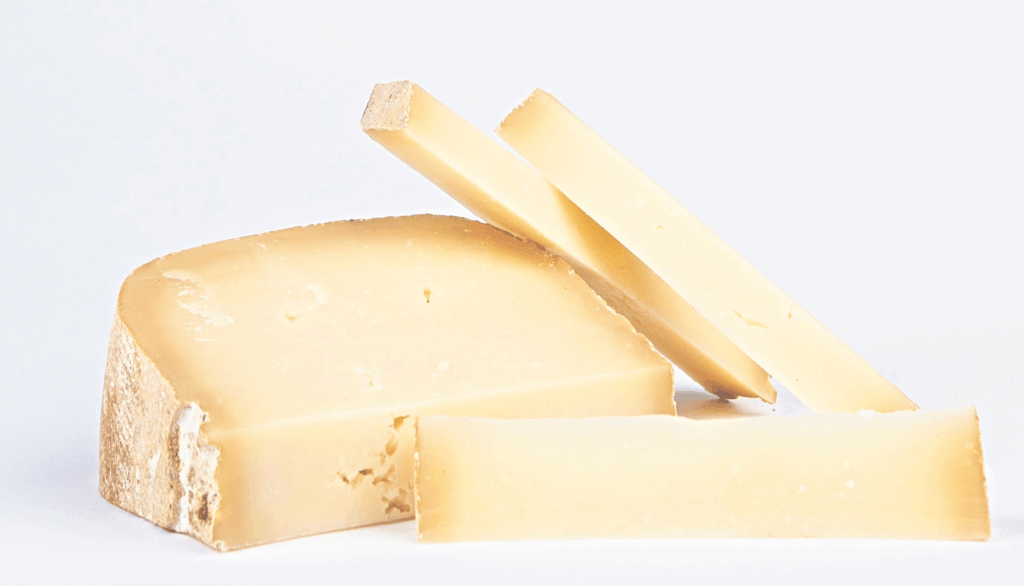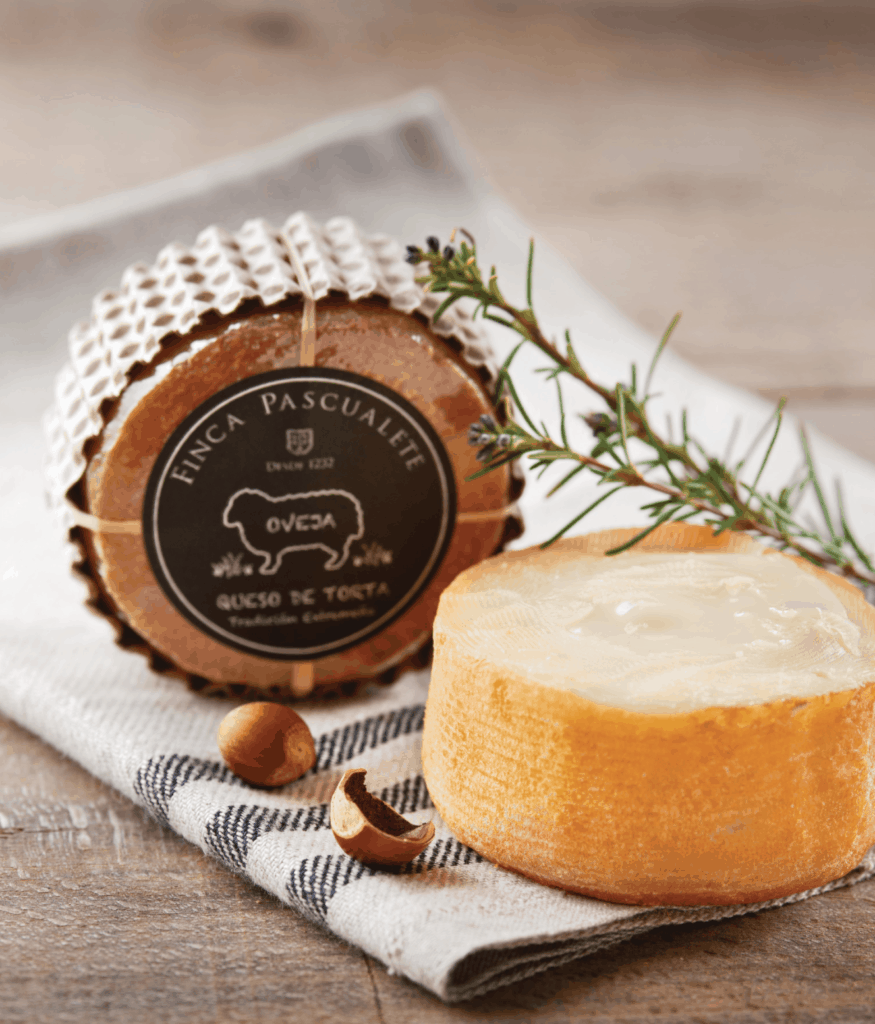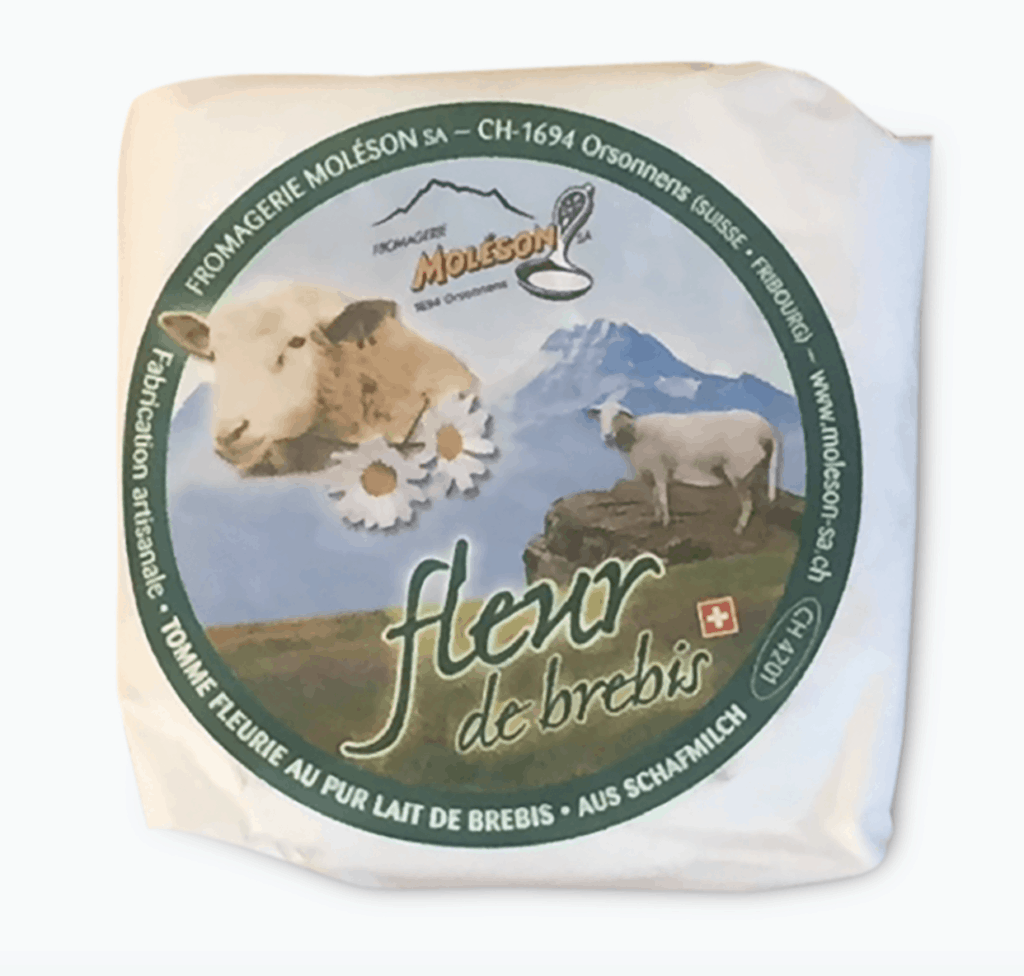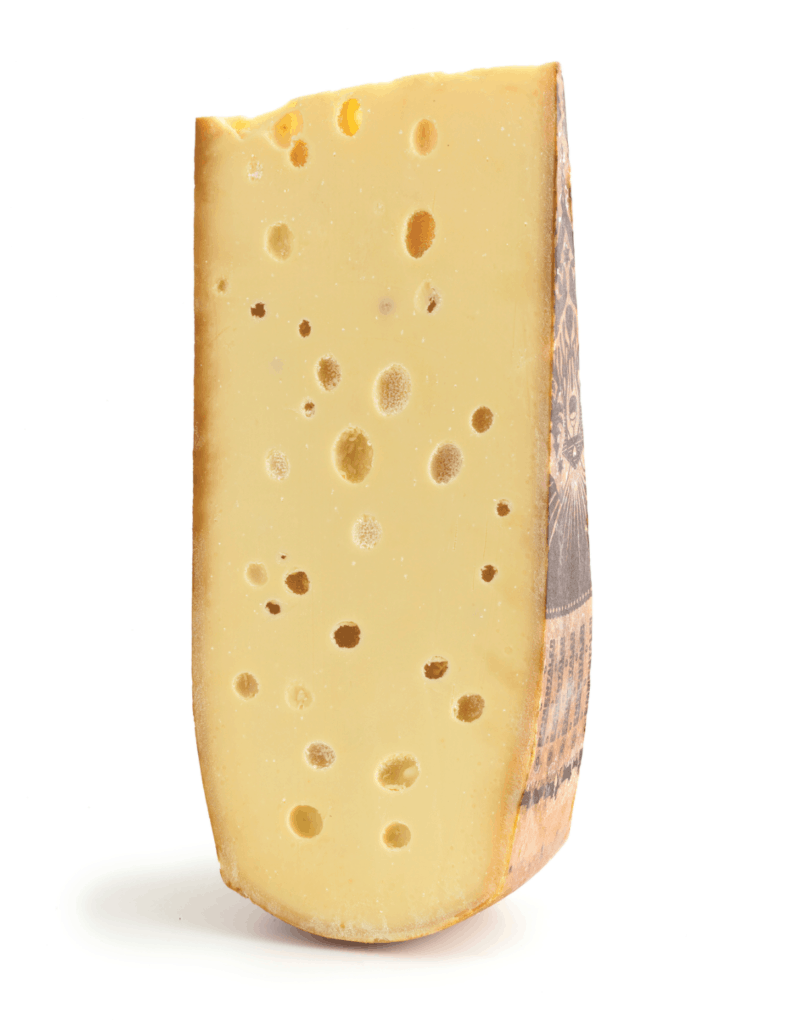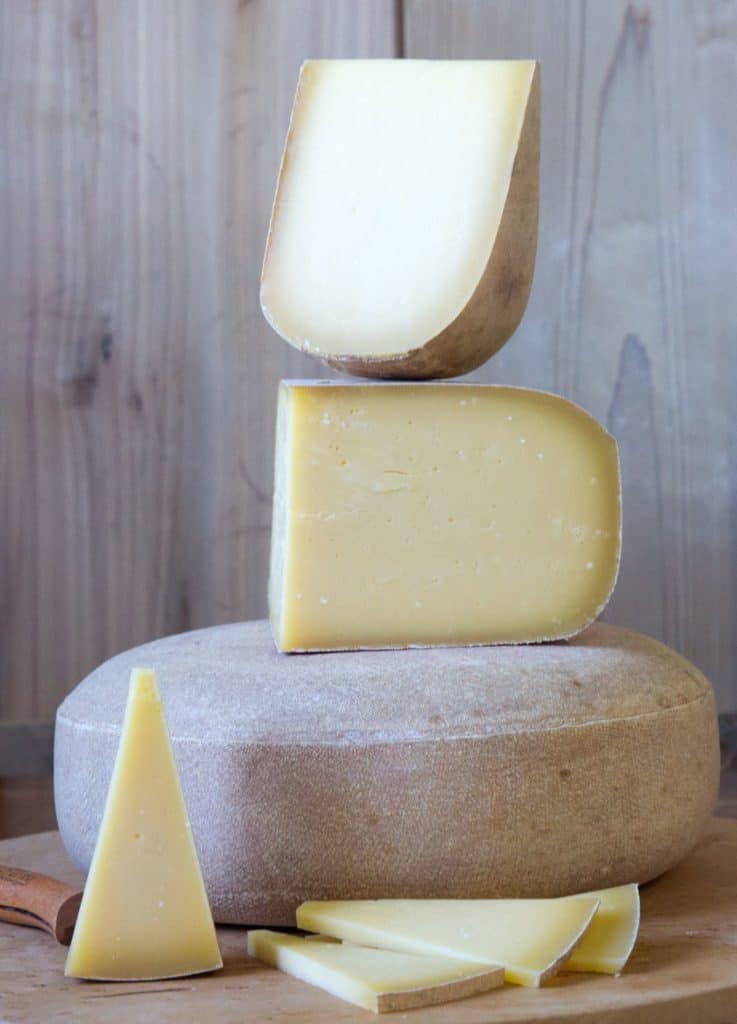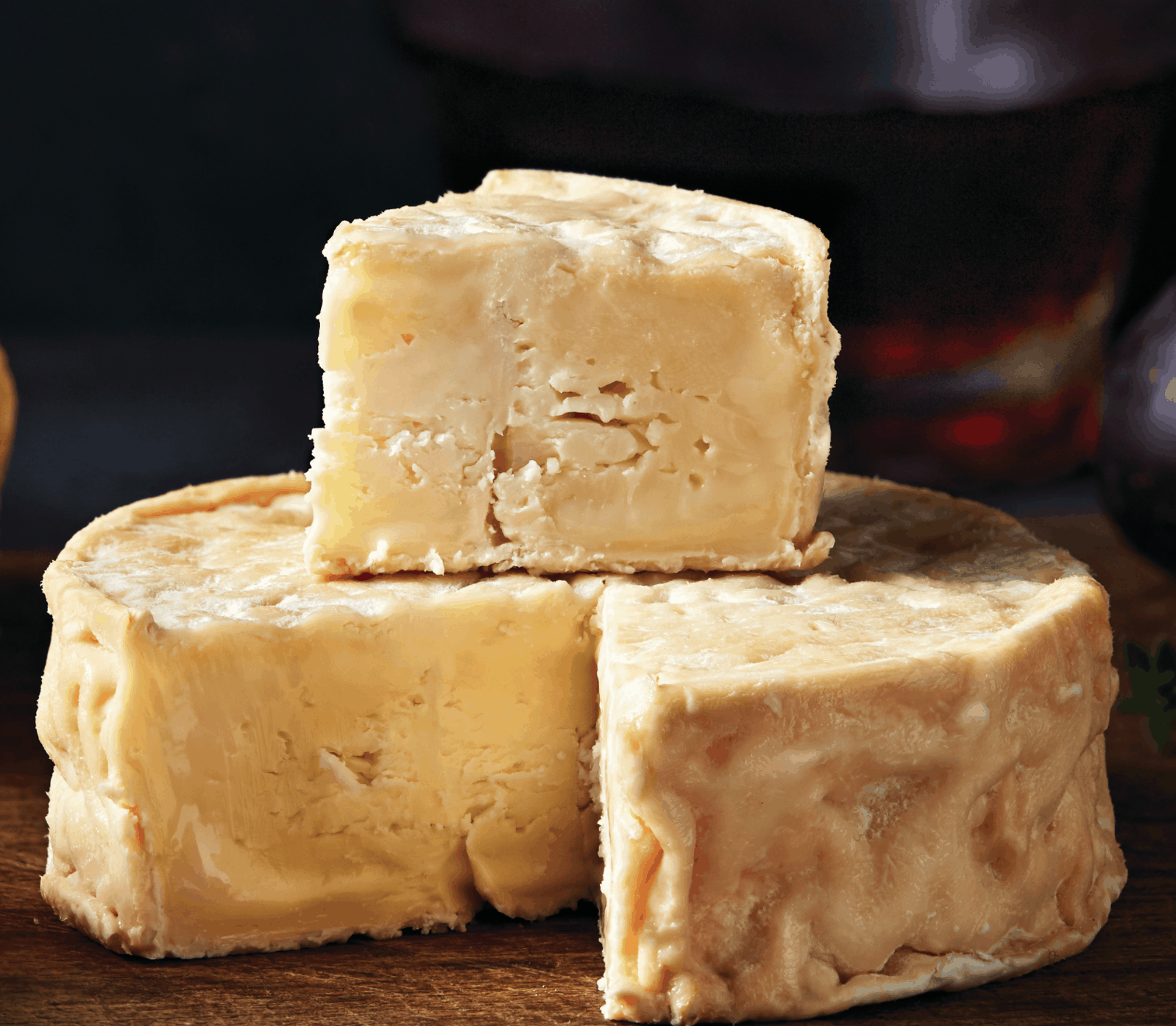
—CLASSICS FROM THE UK—
RACHEL
WHITE LAKE CHEESE, PYLLE, SOMERSET
Rachel is an unpasteurized semi-soft goat’s milk cheese made by Pete Humphries. He named it after an old friend whom he’s described as sweet, curvy, and slightly nutty, which is also an apt description of the cheese. Rachel has a supple, ivory interior and a dusky orange rind, thanks to its signature brine wash. Produced using thermized milk—a method for sanitizing raw milk with low heat—and vegetarian rennet, Rachel’s mellow flavor has minimal goatiness.
MONTGOMERY’S EXTRA MATURE CHEDDAR
MONTGOMERY’S CHEESE, YEOVIL, SOMERSET
Made from raw cow’s milk and cloth-bound aged, this cheddar is produced according to a very traditional recipe, one used by three generations of Montgomery family farmers on Manor Farm, located just 20 miles from the town of Cheddar. The Montgomery Cheddars set the benchmark for modern English farmhouse Cheddar. Now made by Jamie Montgomery, owner and head cheesemaker, these wheels are usually matured for between 12 and 14 months. At this stage, flavors are rich, meaty and robust with sweet—almost caramelized—fruity notes. The added four months in the caves gives the Extra Mature Cheddar a drier texture and a nuttier, peppery taste.
RENEGADE MONK
FELTHAM’S FARM, TEMPLE COMBE, SOMERSET
This washed-rind cheese bucks all British norms. It’s an amalgamation of the continental cheeses maker Marcus Fergusson admires, with the edginess of Époisses, the creaminess of Camembert, and the languid tang of Gorgonzola Dolce. Fergusson adds blue cultures to pasteurized milk, hand-turns the curds, and then salts and pierces them with a bespoke German tool so the holes reseal quickly, rendering the finished cheese veinless. As it cures for four weeks, the cheese is washed in local ale. Finished Renegade Monk varies based on when it is eaten. Younger rounds sport honey yellow rinds and firm, comparatively mild centers. As the sell by date nears, the rind carries a scattering of mold, the core flows and the taste is boldly pungent.
—CLASSICS FROM ITALY—
(Beyond Mozzarella, Parmigiano Reggiano, and Grana Padano)
BONTALEGGIO DI GROTTA TALEGGIO DOP
MAURI FORMAGGI, PASTURO
In 1920 Emilio Mauri found the deep natural caves near the Lombardy village of Pasturo to hold the perfect micro climate for aging cheese. As the snow melts from the Italian Alps above and trickles down through cracks into the caves, the humidity encourages a unique flora to grow on the cheeses’ exterior while the constant 6° C (42.8° F) temperature lets their interior mature slowly, beautifully. Specially selected wheels of Mauri Formaggi Bontaleggio, the maker’s standard washed-rind, cow’s milk Taleggio, are stacked in pine boxes and aged for an extra 50 days in these caves. The added time transforms the traditionally creamy, yeasty cheese into a slightly firmer, richer, and meatier version with a heavier, more pronounced rind.
PIAVE VECCHIO SELEZIONE ORO
AGRIFORM/CBR, BELLUNO
Piave has humble beginnings as the local cheese of Belluno, a town that sits in the dairy farming eastern part of the Veneto. Driven by the consortium of dairy farmers that still makes sure the cheese named after the Piave River is made from at least 80 percent local cow’s milk, the DOP was established for the cheese in 2010. All wheels of Piave—aged between two and 12 months—carry the cheese’s name stamped vertically and repeatedly around their rounded edges. Piave Vecchio Selezione Oro, aged the longest, sports a red label; a tangy, almost juicy aroma; smooth, dense texture; and a light, acidic flavor that ends with a note of pineapple.
ASIAGO DOP
CASEIFICIO PENNAR, ASIAGO
Asiago is produced with milk from cows who graze on the Asiago plateau in northeastern Italy. This class of cheese is subdivided by milk and age. Asiago Fresco, a holey, semi-soft cheese, is made with pasteurized milk from cows grazing in low-lying areas and aged for a month. Asiago d’Allevo, a semi-hard cheese with straw-colored paste, is made with raw milk from cows grazing in the higher pastures and aged up to 24 months. Caseificio Pennar has award winners in both categories. Its Asiago Fresco is delicately sweet and buttery with a slightly salty aftertaste. Its Asiago Vecchio (aged 10 months) and Stravecchio (aged 24 months) have yeasty aromas that hint of dried fruit. As it ages, the cheese gets drier and intensely spicy.
—CLASSICS FROM FRANCE—
ROQUEFORT AOP
RUDOLPH LE MEUNIER, LA CROIX-EN-TOURAINE
Rudolph Le Meunier has been called the “Zidane of fromagers” because a master affineur is just as important to French popular culture as is a national football star. The reputation of Meunier’s Roquefort—a well-known class of blue cheese made with Lacaune sheep’s milk and the mold (called Penicillium roqueforti) originally found in the soil of caves in southern France—is that it is buttery, sweet and creamy. These three features offset the tingly tanginess of the cheese’s signature blue mold and overrule Roquefort’s sometimes overpowering standing, making it a good team player on the cheese plate.
ÉPOISSES PDO
LAITERIES H. TRIBALLAT, RIANS
Laiteries H. Triballat is the family-owned cheese business based in southeastern France that owns the Germain dairy in Burgundy where this award-winning, classic Époisses is made. Époisses, in general, has a bark that is worse than its bite. Like many washed rind cheeses, its pungent aroma is much stronger than the interior flavor of the cheese, which is typically meaty, with waves of sweet, salt, butter, metal, and clean milk flowing over the palate. This Époisses has a beautiful orange rind that has been washed with Marc de Bourgogne (a local grape spirit) and a traditional creamy center that holds an intense but balanced flavor, typical of its class, and a fruity finish.
OSSAU-IRATY
FROMAGERIE AGOUR, HÉLETTE
There is scientific evidence that Ossau-Iraty, a raw sheep’s milk cheese made in the region where France meets Spain along the Pyrenees mountains, was one of the one of the first types of cheeses ever made. It’s sometimes called the “farmer’s dessert” due to its firm but still creamy and buttery texture and its fruity, floral flavor and toasted hazelnut finish. Fromagerie Agour, a family-owned cheesemaking business in the southwest of France, makes its Ossau-Iraty in the purest Basque tradition. It is aromatic, with a balanced, grassy flavor, and a melt-in-your-mouth richness. The combination makes it a great gateway to sheep’s milk cheeses.
—CLASSICS FROM SPAIN—
LA RETORTA MINI
QUESERIA FINCA PASCUALETE, TRUJILLO, CÁCERES
Made with raw sheep’s milk from Queseria Finca Pascualete’s own flock of Extremadura Merino sheep and thistle rennet, these small, hand-pressed rounds are so creamy they can be eaten with a spoon. After aging 60 to 75 days, the flavor is soft, but the aroma tells the story of its south-eastern Spanish terroir: forests filled with oaks, rockrose, juniper, thyme, blackberry bush leaves, and rosemary.
LOMO DEL PALO OVEJA
QUESOS BOLAÑOS, LAS PALMAS DE GRAN CANARIA
Clover, wild lettuce, and arugula—this is the winter diet of the Quesos Bolaños sheep. In summer, the animals head up the mountains, looking for almond hulls, agave, and tagasaste (a member of the pea family indigenous to the volcanic slopes of the Canary Islands). Infused with this bouquet of wild flavors, the sheep’s milk is transformed into semi-soft Lomo del Palo Oveja. Aged for 10 months in natural rock caves, smeared with extra-virgin olive oil, and flipped daily, the cheese is straw-brown in color on the outside and has a buttery texture despite its long aging time. The intense flavor is slightly spicy with delicate roasted notes.
URGÈLIA PDO
CADI COOPERATIVE SOCIETY, LA SEU D’URGELL, CATALONIA
This traditional semi-soft, washed-rind cheese is made from pasteurized cow’s milk, sourced from Frisona cattle reared on local Pyrenees farms. Aged a minimum of 45 days, Urgèlia has a natural, slightly moist, orange-colored rind and a sweet, penetrating aroma. The cream-colored paste has many irregularly shaped eyes and the taste is characteristically soft, pleasant—reminiscent of moss, fungi, and almonds. It is an excellent melting cheese.
—CLASSICS FROM SWITZERLAND—
FLEUR DE BREBIS
FROMAGERIE MOLÉSON, ORSONNENS
Although cow’s milk cheese rules around Fribourg, there’s also a fair number of ewes roaming the lush hills there. Fromagerie Moleson taps them to make a sheep’s milk spin on a traditional Tomme Vaudoise. These Fleur de Brebis spend a scant week in the cellar where they develop fine flowery rinds. When young, the texture is typically tender with a creamy touch and the taste is fresh with only slight ripening tinge. After 10-12 days sitting in the fridge inits packaging, it oozes and has a marked gamey taste.
LE MARÉCHAL
FROMAGERIE LE MARÉCHAL, GRANGES-MARNAND
The Rapin family of cheesemakers receives milk twice daily from 14 producers around the Vaud region, and turns it into cheese within 10 hours of the cows having been milked. Wheels of this flagship Alpine cheese, made the same way since 1992, are brined and then refined with a special mix of organic, aromatic herbs rubbed over the surface throughout their 120-day ripening period. Le Maréchal has a distinctive aroma of butter, dried fruits, and a touch of barnyard. Its flavor is intense, with notes of salted caramel and roasted almonds, and the herbs are more evident toward the edible rind.
GOTTHELF EMMENTALER AOP
KÄSEREI HÜPFENBODEN, GOURMINO, EMMENTAL
Cheesemakers Bernhard Meier and Marlies Zaugg produce this Emmentaler the old-world way. Milk for any Emmentaler AOP cheese comes from local, grass-fed cows.In most Emmentaler AOP production, unpasteurized milk is mixed with proprietary cultures provided by a government-run lab. The wheels at Käserei Hüpfenboden are crafted a little differently. A small amount of whey is removed from the vat during cheesemaking, incubated 48 hours, and used to culture the next batch. After initial aging, Käserei Hüpfenboden wheels go to the underground caves of Gourmino, a company four miles north of the dairy that ages wheels 10 to 24 months and markets them worldwide. The finished product has a firm, fudgy texture with crunchy crystals, and tastes grassy and slightly sweet, like roasted cashews.
America’s “Winningest” Cheese: PLEASANT RIDGE RESERVE
UPLANDS CHEESE CO., DODGEVILLE, WI
This Alpine-style cheese, with its orange-brown rind and smooth texture, was named the American Cheese Society’s Best of Show in 2001, 2005, and 2010. Produced in the Beaufort tradition with high butterfat milk and cold-cellar ripening, Uplands Dairy makes Pleasant Ridge Reserve between May and October when its cows feast on pasture grasses, clover, herbs, and wildflowers. The complex milk gives the cheese a layered flavor—rich and deep, with hints of caramel and salt, and a grassy, floral finish. It is sold at two ages: Regular and Extra-Aged, which spend 7-14 and 15-20 months in the cave, respectively.
Cheese to Transport You for an Instant Sense of Place: CAMEMBERT DE NORMANDIE PDO
FRANCE
This iconic French-made cheese is formed into eight-ounce rounds and packed in lovely little wooden boxes. Camembert de Normandie is covered with a white, bloomy mold and smells of mushrooms and a clean cellar. The texture is supple, yielding, and consistent and the paste is a deep, golden yellow that runs more with age. The flavor is buttery with a hint of truffles. Well-known brands include Moulin de Carel, Ferme de la Héronnière, and Grand Beron. True Camembert de Normandie rounds are made from raw milk and aged less than 60 days and therefore not legal for export to the United States. There are French producers, though—like Le Chatelain—making excellent Camembert-style cheese with pasteurized milk.
Cheese Making PDO News: PAŠKI SIR
GLIGORA DAIRY, KOLAN, CROATIA
Paški Sir, a hard sheep’s milk cheese from the island of Pag, was the first in Croatia to earn PDO status in 2019. Located in the Adriatic Sea, this island has long been associated with salt production and a unique breed of sheep called Paška Ovca. Since they don’t produce much milk, at least 16 are needed to produce one wheel of Paški Sir. A hard cheese aged between four and 18 months, it has a thin rind and a paste ranging in color from light to dark yellow, depending on age. The texture is dry and flaky with a pleasant graininess. The flavor of a younger wheel is lightly savory with a good amount of salt. As a wheel matures, the savory flavor intensifies, and a tangy bite develops.



